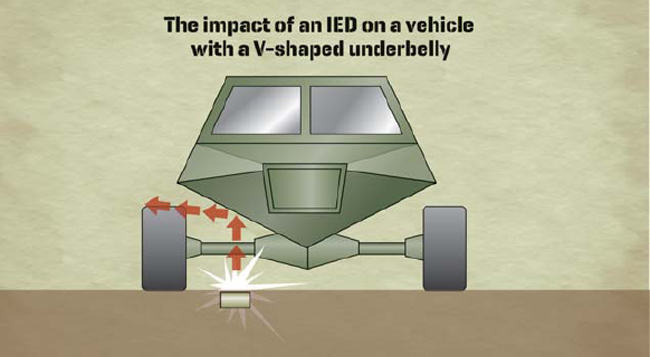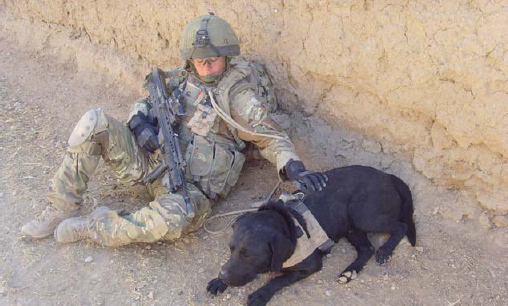Avoiding anti-vehicle mines
When you are on the road you are relatively safe from mines (obviously not from IEDs) but when you go off road you are vulnerable. The good news is that with a vehicle you have some protection. Of course if you blow up enough explosive under any vehicle it will kill everyone inside but the mine protection on vehicles is getting better and the chances are that you will get away with it most of the time.
The down-side is that you cannot look at the ground when you are travelling at vehicle speed so mines are hard to spot. Stay on the road when you can. When you have to go off road try not to follow a track and head cross-country. Avoid bottlenecks at bridges, fords etc as this is where the mines will be. By far the safest way is to get locals to hitch a ride – and failing that keep an eye on where other road users go and drive in their tracks.
Action on detonating a vehicle mine
If your vehicle hits a mine, and remember you cannot know at the time if it is a mine or an IED, then take action as if you are going to come under fire as this often follows an IED strike. Someone needs to call in a contact report so your boss isn’t worrying about you and you may even get some support or a casevac. The main injuries from explosives going off underneath armoured vehicles is to your feet and lower legs from the shockwave hitting the floor and your spine from the vehicle jerking rapidly upwards. In view of this there is an argument for keeping your feet off the floor and sitting well strapped into a sprung seat to save your spine.
Depending on the vehicle damage, casualties and if you have other vehicles you may choose to jump out and take up a defensive position, return fire from an armoured vehicle which is unlikely to be hit by another mine as it is not going anywhere, or you may jump into your other vehicles and make off. If you have to run away make sure you take or destroy all papers, maps and personal possessions. Then destroy the vehicle you are leaving as the opposition will certainly search it and take anything useful.
IEDs
As you probably already know, an IED can be planted almost anywhere – it can be in soft ground or placed in a tunnel under a road. There is little difference between an IED aimed at foot soldiers and one aimed at a vehicle except possibly size of charge and that if the enemy are clever enough they may be able to make a shaped charge to give better penetration of the armoured vehicles underside.

Avoiding IEDs
This is not easy but it is one of the most important skills the soldier will learn in this book. The first few tips are for the ordinary soldier to improve the chances of his team. The real counter to IEDs is high tech and mentioned below as far as is safe to tell:
Soldiers
Technical
Vehicle protection
All things being equal, the more armour under a vehicle the bigger bang it can survive but this quickly puts you in the situation where the vehicle cannot move at any speed. I have seen a main battle tank turned over on its top like a tortoise by a large IED.
You might think a bomb under a motor vehicle is just a bomb but not so. Mines always explode under the wheel or track of a vehicle and to a great extent this channels the blast away from the crew cabin for the loss of a wheel. Which is a pretty good bargain in my book. An IED, on the other hand, can explode anywhere under or near the vehicle. This means that an IED with a shaped charge directing the blast straight upwards can be very effective against the crew of a vehicle.
To cut down on weight while maintaining protection it is a good idea to use vehicles with a V-shaped under-belly. I used vehicles of this type manufactured by the South Africans more than 30 years ago and the armour sloping away from the blast – be it mine or IED – really does cut down on both penetration of the vehicle and the lifting of the vehicle which causes so many injuries to feet, legs and spine.
Action on detonating an IED
When there is an explosion amongst your patrol or your convoy you cannot know immediately if it was a mine or an IED. A mine is a one-off event and there may not be an insurgent for miles or any further problems but an IED certainly has at least one person watching, as they triggered it, and there may be a whole ambush party. Worse, there may be another IED placed close to the original blast just where your people will rush to take up a defensive position or where you are likely to set up a command position while you give first aid.
Your first problem is what to do about the casualty – and this is not an easy decision. So many men have been killed by the second blast while going to the aid of their wounded comrades that you really should leave him until the area is secure. If he looks dead, certainly do not approach his body. Many men feel obliged to go to the aid of their wounded mates, I can understand that and they are heroes for doing it, but it is a bad tactical decision so make sure no more than one man goes to the casualty. And be aware you may lose him too.
The rest of the patrol should take up a defensive position as if coming under fire. But be aware that this is exactly what the insurgents expect and so you should avoid obvious positions like ditches as these places may be mined or have further IEDs waiting.
Do not think this will not happen to you
I am going to tell you a story now so that you remember. Every word is true – my mate ‘Bow’ Collington of 2 Para was there and you can check the story out on the internet or in records. In August 1979 a number of British Paratroopers were driving in a convoy of 4-ton soft skinned trucks near a place in Northern Ireland called Warrenpoint. As they passed a road-trailer the IED hidden within it – 400lb of Amfo fertilizer explosive – was detonated by radio signal, using a model aeroplane transmitter, destroying the rear vehicle and killing six Paratroopers. Without electronic equipment there was no way to avoid this bomb.
